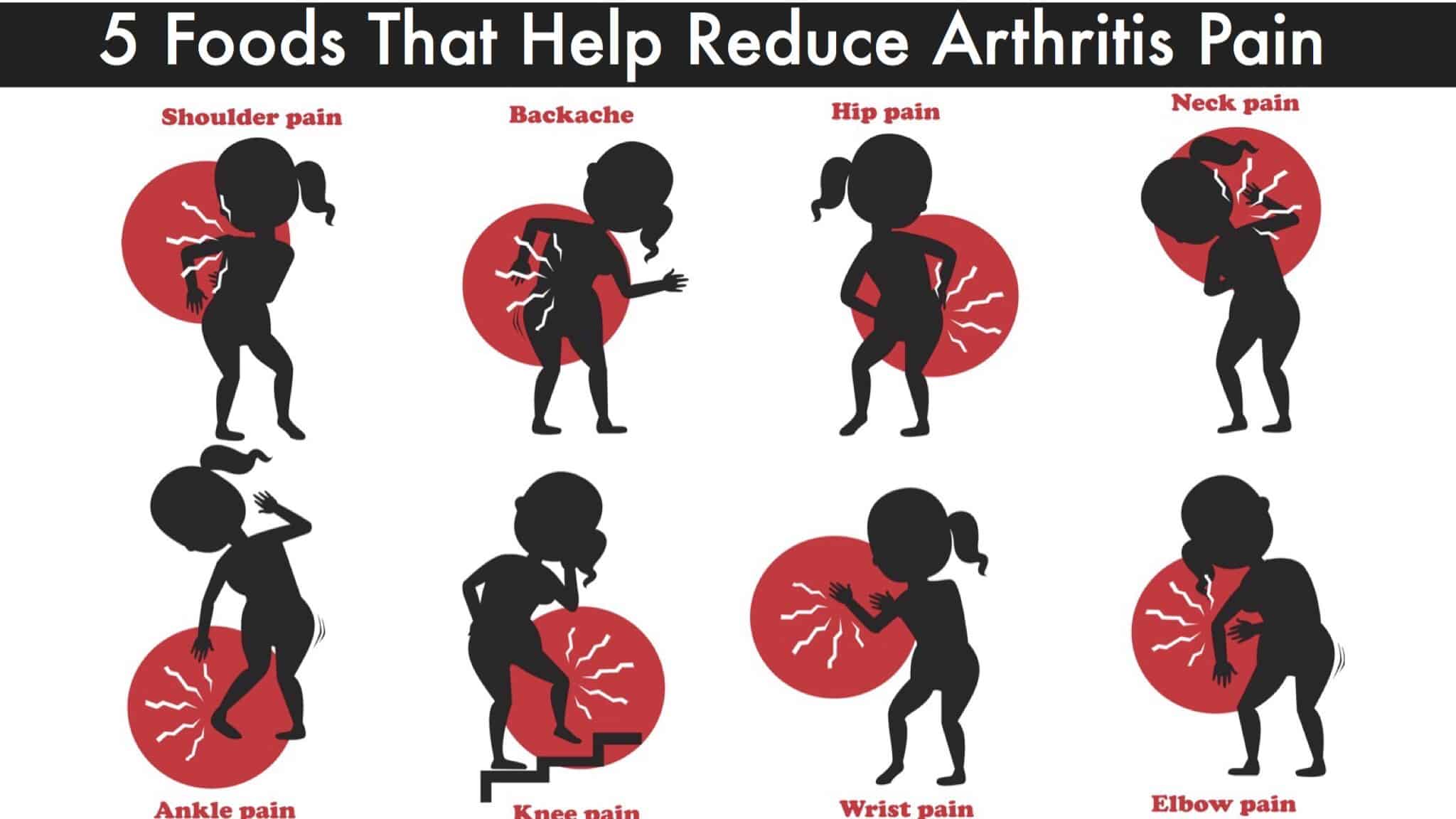Arthritis causes joint pain, stiffness, swelling, and a limited ability to move easily. Although it can be mild to moderate, it often worsens as the years go by. Extreme arthritis causes chronic pain and sometimes the inability to do regular activities like walking up the stairs. Arthritis may cause deformed fingers, joints, and even organ damage depending on your arthritis.
You can reduce arthritic pain by staying active, having a healthy weight, and eating a healthy diet.
“Things that most people take for granted, for example sleeping, bathing, brushing one’s teeth, getting dressed, making meals, and even driving a car, are extremely challenging for me.” ~ Mrs. ‘K.D.’: “Living With Rheumatoid Arthritis.:
According to the Centers for Disease Control and Prevention, arthritis affects nearly 55 million American adults. There are over 100 different forms of arthritis and relative diseases. The most common types being osteoarthritis (OA), rheumatoid arthritis (RA), psoriatic arthritis (PsA), fibromyalgia, and gout.
There is one common denominator between all of them: joint pain. Aching, dull, hot, throbbing joint pain. As anyone who has suffered from the condition can attest, joint pain is among the worst pain types in existence. The inflammation of intersecting bone, cartilage, and ligaments defines the aches and pains associated with arthritis.
Why Food May Be The Best Option for Arthritis
“Let food be thy medicine and medicine be thy food.” ~ Hippocrates
Prescription drug costs continue to soar. As a result of these exorbitant prescription drug costs, many seniors turn to high doses of over-the-counter meds (e.g., NSAIDs, aspirin) known to cause health problems ranging from headaches and dizziness to liver failure. Consider that many seniors are on a fixed income, and it’s clear that we have a big problem.
Perhaps the most feasible way to manage arthritic pain is through nutrition. According to The Brisbane Clinic of Nutritional Medicine, “Diet has been strongly implicated as a cause and therapy for many forms of arthritis. Unfortunately, this aspect is often overlooked and underestimated.”
What are the four types of arthritis?
Degenerative arthritis
Osteoarthritis is the most common arthritis. It happens when your cartilage wears away so that your bones to rub against the bone at your joints. You also have swelling, pain, and stiffness. You’re more at risk for osteoarthritis if you’re overweight, injured your joints, or have a family history of arthritis. The best prevention is staying active, eating well, and using pain relievers as needed.
Inflammatory arthritis
Some arthritis causes your immune system to break down by attacking your joints, causing inflammation and damage. Researchers think this arthritis is an autoimmune reaction triggered by genetics or environmental situations. Inflammatory arthritis must be diagnosed early so you can get the proper treatment. Mediation can slow down your immune response.
Infectious arthritis
If a bacteria, fungus, or virus gets into your joints, it can trigger this type of arthritis. Salmonella (food poisoning), chlamydia, gonorrhea (sexually transmitted diseases), and hepatitis C can all cause infectious arthritis. If these diseases are caught early enough, they can be treated with antibiotics.
Metabolic arthritic
Uric acid is found in your cells and some foods. If you have too high of uric acid in your body or have difficulty getting rid of uric acid, you can end up with metabolic arthritis in your joints. People with too much uric acid are also prone to gout, which causes excessive pain and discomfort.
So, what are the best foods to help reduce arthritis?
It’s no secret that eating certain foods may help you stave off arthritis pain. Here’s a list of some of the best foods you can eat to help reduce arthritis
15 Foods That Can Help Reduce Arthritis Pain
First, it is crucial to be aware of and clear from “trigger foods.” Trigger foods produce an allergic or unfavorable bodily response (usually inflammation). Common trigger foods include dairy, red meats, wheat, corn, beef, and nightshade vegetables. Once you’ve identified and actively avoided your food triggers, you can focus on nutritional healing.
With that in mind, fifteen foods may help significantly reduce arthritis pain.
1. Apples
Apples are loaded with two powerful bioflavonoids, quercetin, and rutin. Both inhibit histamine release, protect the body from inflammation, boost blood circulation, and promote cellular health.
Other excellent quercetin and rutin sources include chamomile tea, celery, capers, citrus fruits (orange, grapefruit, lemon, lime), cranberries, green peppers, and onions.
2. Almonds
Make that a second non-meat source! Almonds are the most abundant source of vitamin E at 7.3 milligrams (mg) per ounce. Vitamin E helps stabilize cell membranes and, together with zinc, promotes cartilage growth.
Other top vitamin E sources include spinach, sweet potatoes, avocado, wheat germ, palm oil, butternut squash, and sunflower seeds!
3. Coldwater fish
Coldwater fish contain abundant omega-3 fatty acids, which have potent anti-inflammatory properties. Omega-3’s contain eicosapentaenoic acid (EPA) and docosahexaenoic acid (DHA), also known as marine fatty acids. EPA and DHA suppress the body’s inflammatory response by interfering with the immune cells and enzymes involved.
The best marine omega-3s are salmon, tuna, sardines, and mackerel. Vegans and vegetarians can acquire omega-3s through flaxseed, chia seeds, soy, kale, and other plant-based sources.
4. Eggs
The protein in eggs can significantly increase the levels of tryptophan in the blood. Tryptophan is the building block of serotonin; the brain chemical stabilizes mood and boosts the pain threshold. Tryptophan also raises endorphin levels in the brain and body!
Cheese, salmon, and turkey are also excellent sources of tryptophan. Vegan and vegetarian options include nuts and seeds, pineapples, and tofu.
5. Lamb
Lamb is an excellent zinc source, an essential mineral with many functional roles in the human body. According to the Arthritis Association, “Studies show significantly lower zinc levels in people with rheumatoid arthritis compared to those without it.” Individuals whose tests revealed “the lowest levels (of zinc)” tended to have it worse.
Other meat sources of zinc include seafood, red meat, and poultry. Fortified cereals, beans, nuts, seeds (especially pumpkin!), and whole grains are good non-meat sources of the mineral.
6. Fatty fish-Salmon, tuna, sardines, and mackerel
High in omega 3s, these fatty fish help your brain function, boost your immune system, and fight heart disease. Fatty fish also reduces inflammatory proteins that build up in your body. Eat fatty fish often for the best results to lower your inflammation with added benefits to your heart and brain.
7. Seeds and nuts
Eating nuts and seeds are high in omega-3s. Almonds, flax seeds, walnuts, chia seeds, and pine nuts are also high in fiber, calcium, zinc, and vitamin E, which have many anti-inflammatory benefits. Nuts and seeds are also good for your heart. Heart health is essential, especially for people who have rheumatoid arthritis. Researchers found that people with rheumatoid arthritis are at a higher risk of getting heart disease. Make a healthy trail mix with seeds and nuts sprinkled with olive oil and salt. Roast in a 350 oven for 20 minutes.
8. Dark leafy greens
Leafy greens are so good for you and are high in folate, Vitamin C, and calcium. Eating spinach, collard greens, or kale will help you fight off inflammation. Eating leafy greens also provides your body with extra collagen, an essential part of cartilage in your joints. Other benefits of leafy greens include
- Improves brain function
- Boosts your digestion
- Removes toxins
- Aids bone health
- Boosts your immune system
- Helps relieve stress
- Relieves stomach bloat
- Helps you age well
- Manages blood sugar
Eat the leafy greens raw in a fresh salad or saute them with olive oil and serve as a side at dinner. You can also throw leafy greens like kale into your afternoon smoothie for a healthy snack.
9. Garlic and onions
Pungent veggies like garlic and onions have arthritis-fighting properties. These two have a long list of benefits, like
- Fighting inflammation
- Lowering cholesterol levels
- Fights heart disease
- Lowers blood pressure
- Protects against blood clots
Use garlic and onions in your cooking as much as possible. These two powerhouse foods add great flavor to stews, sauces, and meat dishes.
10. Berries
Strawberries, blueberries, blackberries, and raspberries contain antioxidants and anti-inflammatory benefits. High in vitamin C, they boost your immune system, so you can fight off arthritic conditions and infections. Eat fresh berries by the handfuls, or use a berry mix in your morning smoothie. Berry’s other benefits include
- High fiber for digestive health
- Rich in antioxidants for fighting illness
- Folate to fight depression
- High in anthocyanins for good heart health
- Manage blood sugar
- Help urinary health
11. Whole Grain Bread and Cereals
Whole grains and cereals contain B vitamins. Researchers say eating food high in B vitamins relieves osteoarthritis joint stiffness and pain. Whole grains and cereals contain thiamine, folate, riboflavin, niacin, and minerals like iron, magnesium, and selenium, all of which help you fight chronic diseases. Instead of eating white rice, try whole grains like brown rice or quinoa. Buy or make whole multi-grained bread instead of white bread. These small changes will give you big health results.
12. Pineapple
Pineapple is an athlete’s best friend. Pineapples have an enzyme called bromelain that can reduce inflammation. It’s also packed with Vitamin C which boosts your immune system so you can fight off disease better. You can eat fresh pineapple or from a can. If you buy it canned, be sure it’s not packed in syrup. Put pineapple in your morning smoothie or grill slices next to your meat. You can also mix up a frozen pineapple treat with this simple recipe.
Frozen pineapple treat
Ingredients:
- 2 cups of frozen pineapple pieces
- 1-1 ¼ cups of orange juice
Directions:
- Put the frozen pineapple pieces and orange juice into a blender. Blend on high until it’s whipped. Delicious!
13. Ginger
This pungent spice contains curcuminoids, which can fight inflammation and boost your immune system. Ginger can be used in a cream or oil applied to the areas of your body where you have pain. Additionally, you can make ginger tea or add fresh ginger to recipes to help your immune system.
14. Peanut butter
Another vitamin B-rich food, peanut butter, helps improve flexibility and fight inflammation. It’s rich in protein and healthy fat. High in fiber, eating peanut butter can help you lose weight. It’s so satisfying you don’t feel hungry. So try making your peanut butter at home. Here’s an easy recipe.
Ingredients:
- Roasted peanuts around 2 cups
- Sea salt (if preferred)
- ½ teaspoon of honey (if preferred)
Directions:
- Put the peanuts into your food processor. Then blend them for around five minutes. Depending on your processor, it may take as long as 10 minutes. Wait until it completely creamy without ground peanuts in it.
- Add salt if preferred.
- Add honey if preferred.
Store your fresh peanut butter in the fridge for up to 3 months.
15. Orange Juice
Rich in vitamin C, folate, potassium, and magnesium, drinking orange juice isn’t just for your kids. A glass of orange juice a day boosts good cholesterol and lowers bad cholesterol. Vitamin C is known for its significance in developing good healthy cartilage. You can squeeze your fresh orange juice or eat the whole orange. Just be sure to save the rind for orange zest for dessert recipes. Throw the rind into a zip bag and freeze until you need it.
Final thoughts on reducing arthritis pain with an anti-inflammatory diet
Arthritis limits your ability to do the things you love. Eating healthy foods and staying active can help, but you need to find ways to fight the painful swelling and inflammation if you get arthritis. Researchers have found that many foods can help relieve the pain and swelling of arthritis. So include these foods in your regular diet to boost your immune system and relieve pain.

















 Community
Community

